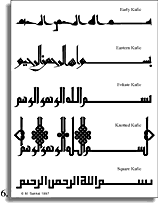Part 3 of 5 articles The Art of Arabic Calligraphy |
|
The Kufic Styles© Mamoun Sakkal 1993 |
|
| The city of Kufah was established in Iraq in the year 641 A.D. It flourished
in a short time from a soldiers' camp into an urban center with vital cultural
activities. Among these activities was the refinement of the Arabic script
into an elegant and rather uniform script, which came to be known as Kufic
or Kufi. It had a combination of square and angular lines on one hand, and
compact bold circular forms on the other hand. The vertical strokes were
short, while the horizontal strokes were long and extended. As Kufic reached
perfection in the second half of the 8 th century, it superseded other earlier
attempts of improvement of Arabic calligraphy, and became the only script
used for copying the Holy Quran for the next three hundred years (Fig. 6). When the cursive styles were becoming popular and refined in the 10 th century, Kufic responded by overemphasizing many qualities of the cursive scripts in a geometrical style called 'Eastern Kufic,' where slender vertical strokes and oblique strokes animate the more rigid early Kufic. This style was mainly a book calligraphy rather than architectural calligraphy style, but was very popular on ceramics. On architectural monuments, serifs were added to simple early Kufic since the 8 th century, and leaf-like vegetal ornaments appear as early as 866 at the ends of vertical strokes. These ornaments were later added to round strokes, and the Foliate Kufic became the most popular style for architectural inscriptions since the 10th century. In the 11th century the letters themselves started to be modified and used as ornaments, and new geometric elements started to appear in the form of plaiting, knotting, and braiding2. The exaggerated use of such ornaments created complex compositions, which were difficult to decipher at times. During the 13th and 14th centuries, Square Kufic developed out of the use of calligraphy in buildings. Its simple forms contrast with the trend to develop more complex calligraphic compositions. It was the only calligraphic style used to cover entire buildings, a practice unique to Islamic architecture. An example of the Maghribi (western) style which retains much of the qualities of Kufic but with more flowing and cursive lines and delicate, rather than heavy proportions and forms, is shown in the next section which deals with cursive styles. Article and figures © copyright 1993 by Mamoun Sakkal, updated 12/27/2016 |
|
Fig. 6. Samples of Kufi Styles of Arabic calligraphy. From top to bottom: Early Kufi, Eastern Kufi, Foliate Kufi, Knotted Kufi, and Square Kufi. Click on image for details |
|

